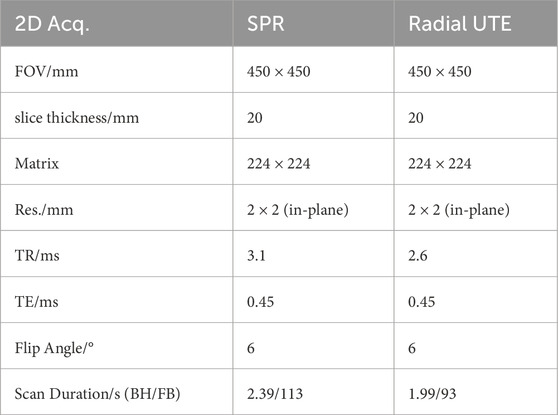- Department of Internal Medicine II, University Ulm Medical Center, Ulm, Germany
Purpose: To investigate the performance of retrospective self-gating techniques in combination with the single-petal rosette (SPR) trajectory for 2D imaging of the lung.
Methods: Eight healthy volunteers underwent free-breathing and breath-hold MRI using the single-petal rosette trajectory (SPR), as well as radial UTE acquisition combined with the tiny golden angle acquisition scheme. Retrospective self-gating techniques (k-space based, image based and nuSG) were used for reconstruction with temporal resolutions of 50, 75 and 100 ms. The SPR trajectory was compared with the conventional radial UTE technique regarding image sharpness and signal-to-noise ratio (SNR) for all investigated resolutions.
Results: Low-spatial high-temporal resolution images used for image-based self-gating techniques benefit from more the efficient k-space sampling pattern of SPR. Image sharpness values are lower for SPR compared with radial UTE for all temporal resolutions but especially prominent for 75 ms temporal resolution. The same was found for SNR, where the highest increase was found for a temporal resolution of 75 ms.
Conclusion: Exploiting the higher efficiency in k-space sampling of the full-petal SPR for image based self-gating can be a means of decreasing temporal resolution.
1 Introduction
Evaluation of pulmonary function and structure can be done non-invasively using lung magnetic resonance imaging (MRI). The development of reliable and innovative imaging techniques is in increasing demand to address the challenges of lung magnetic resonance imaging, such as respiratory and cardiac motion and low signal intensity of the lung parenchyma due to low proton density. Magnetic resonance imaging of the lung has the advantage of analysis of lung function, including fractional ventilation [1] (FV) and perfusion [2], which probably provides valuable information on lung physiology.
Radial (center-out) k-space sampling schemes, such as radial ultra-short echo time (UTE) [3] and zero echo time (ZTE) [4] have developed to be suitable sequences to counteract the intrinsically short
However, respiratory and cardiac motion still severely limit scan duration, even when exploiting the sub-Nyquist imaging capabilities of UTE sequences, especially by employing specific angular increments [8–11]. More efficient k-space coverage can be achieved by, e.g., the single-petal rosette trajectory (SPR), which has been proven feasible for imaging of the lung [12, 13] and the brain [14, 15], as well as quantification of the sodium content in articular cartilage [16], which all present with low
It has been proposed that the increased k-space coverage of the SPR trajectory could be exploited to decrease temporal resolution of retrospective self-gated images, while keeping the radial UTE-like contrast by only using the center-out half of the petal for final reconstruction. In this work we combine the SPR trajectory with k-space based, as well as image-based retrospective self-gating techniques, including non-uniform self-gating (nuSG) [21] and comparing the performance with radial UTE.
2 Methods
2.1 MR imaging
This work compares two center-out UTE trajectories providing similar contrast. The classic radial UTE [1] that is realized by a straight radial center-out read-out (RO), followed by a rephasing gradient along the same trajectory before spoiling. The second trajectory takes advantage of the rephasing time and replaces the reversed gradients in radial UTE by a rosette petal parametrized by
where
A parametrization of the SPR trajectory of
Images were acquired on a Philips 3 T whole body MRI (Ingenia 3.0 T CX, Philips Healthcare, Best, Netherlands) using a 16ch DStream torso coil (Philips Healthcare, Best, Netherlands) in combination with an integrated 16ch posterior coil.
In-vivo imaging was performed in eight healthy volunteers with no reported respiratory disorders, with written informed consent obtained prior to examination. A single coronal slice, centered at the bifurcation of the trachea was acquired in each volunteer. Said slice was measured three times for each of the two trajectories (SPR and radial UTE): once in the inhaled state (breath-hold), once in the exhaled state (breath-hold) - each for a duration of 2.4 s for SPR and 1.99 s for radial UTE - and once continuously during free breathing for a total scan duration of 113 s for SPR and 93 s for radial UTE.
2.2 Reconstruction
After data acquisition, raw data were exported and processed with MATLAB (MathWorks, Natick, Massachusetts, United States). Images were obtained using gridding [22] with an oversampling factor of 1.25, a Kaisser Bessel kernel for interpolation and in combination with a 2D Voronoi tessellation for density compensation. During trajectory calculation gradient delays were carefully considered [23] and remaining eddy current induced distortions modeled by a mono-exponential decay function [24] with time constant of
For evaluation of the trajectory performance for different temporal resolutions when using self-gating, 4 different retrospective self-gating techniques were compared:
The k-space based approach [17–19] uses the during each read-out intrinsically measured DC-signal from manually selected coil elements. The DC-amplitudes are bandpass filtered using cut-off frequencies that are individually determined for each volunteer based on a power spectrum analysis. Principal component analysis yields the final respiratory navigator signal that is subsequently sectioned equidistantly along the time axis to obtain the respiratory stages.
The images-based approaches [7, 20], as well as the nuSG approach [21] rely on low-spatial high-temporal resolution images. The required dynamic data is reconstructed applying a sliding window technique with temporal resolution per image of 100, 75 and 50 ms, resulting to 32/39 read-outs for a resolution of 100 ms, 24/29 read-outs for a resolution of 75 ms and 16/19 read-outs for a resolution of 50 ms for SPR/radial UTE, respectively, for the sliding-window reconstruction.
In case of the image-based gating reconstruction, a line was manually placed over the lung-liver interface (LLI). Its line profile automatically underwent gradient analysis to obtain the self-gating signal. The identification of the respiratory stages followed a histogram-based binning approach for the first image-based self-gating technique
The nuSG reconstruction is based on the reconstruction process that is described in detail in [21]. The low-spatial high-temporal resolution images obtained by the sliding-window reconstruction were used to identify a region of interest (ROI) covering the LLI and, by pairwise correlation of all frames, a correlation matrix
All self-gating reconstruction techniques are described in further detail in [25].
2.3 Image analysis
For further assessment of all images, the parenchyma was segmented semi-automatically by manually drawing approximate contours around the left and right lung and by subsequently applying intensity thresholds to exclude large vessels.
The signal-to-noise ratio (SNR) of the lung parenchyma was calculated according to [26] by
where
To check for statistically significant differences in SNR, a Wilcoxon signed-rank test for paired samples was performed, with
Image sharpness assessment was done across an intensity line profile over the LLI. The position of the pixels corresponding to 25 and 75
3 Results
3.1 Image quality and overall gating performance
Data acquisition was completed successfully for six volunteers, the data of two volunteers needed to be excluded due to insufficient image quality of the radial UTE images. Images of one volunteer are exemplarily shown in Figure 1 for breath-hold, as well as all self-gating reconstruction techniques at all investigated temporal resolutions for radial UTE and SPR trajectory. Additionally, Figure 2 shows the images reconstructed using
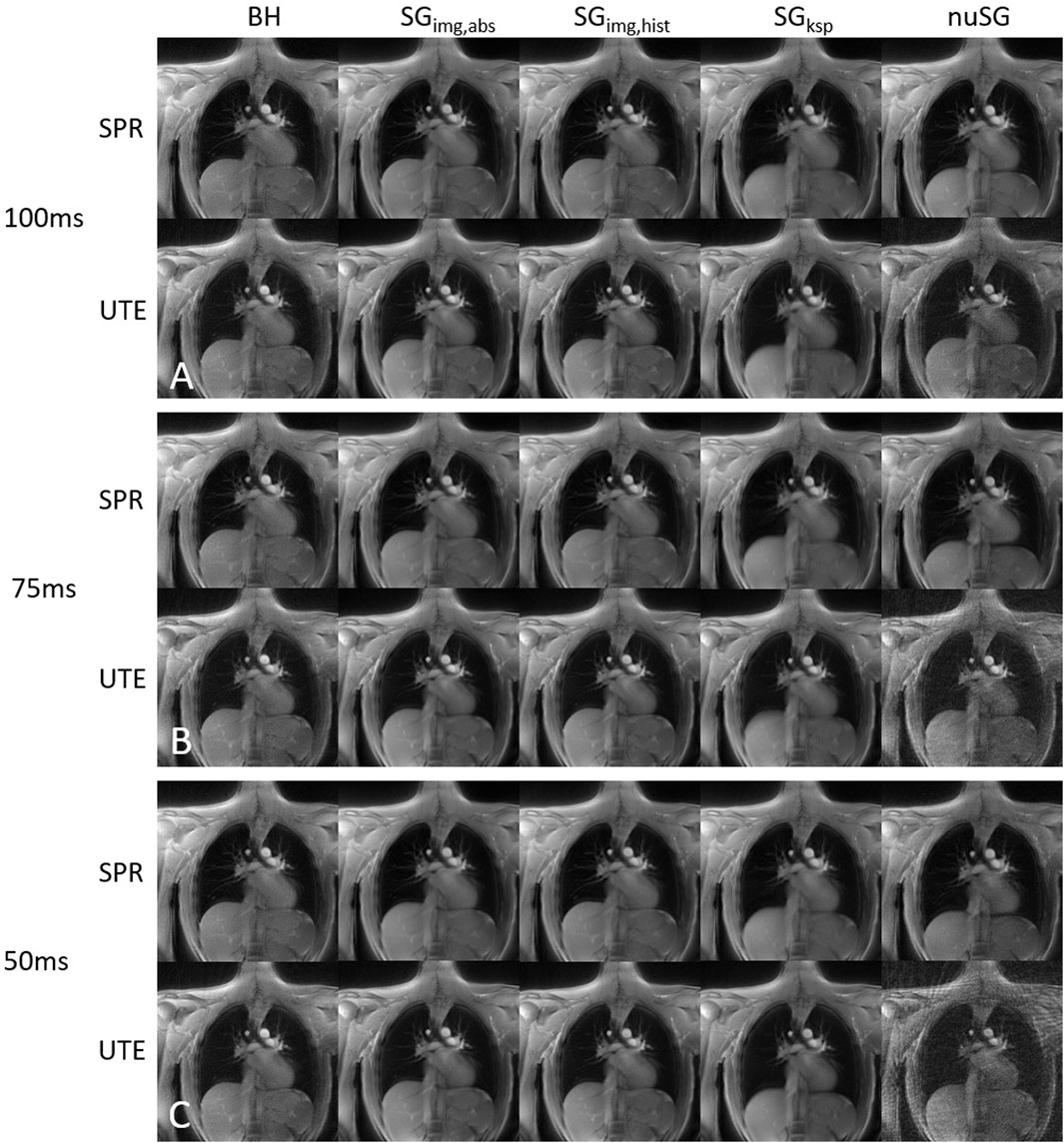
Figure 1. 2D coronal lung images during expiration stage. All images with same investigated temporal resolution are combined in one block, the top one (A) representing a temporal resolution of 100 ms, the middle block (B) a temporal resolution of 75 ms and the bottom block (C) a temporal resolution of 50 ms. Each block consists of two rows, where the top row shows images acquired using the SPR trajectory and the bottom row images acquired using radial UTE. The columns correspond to the breath-hold images and gating techniques
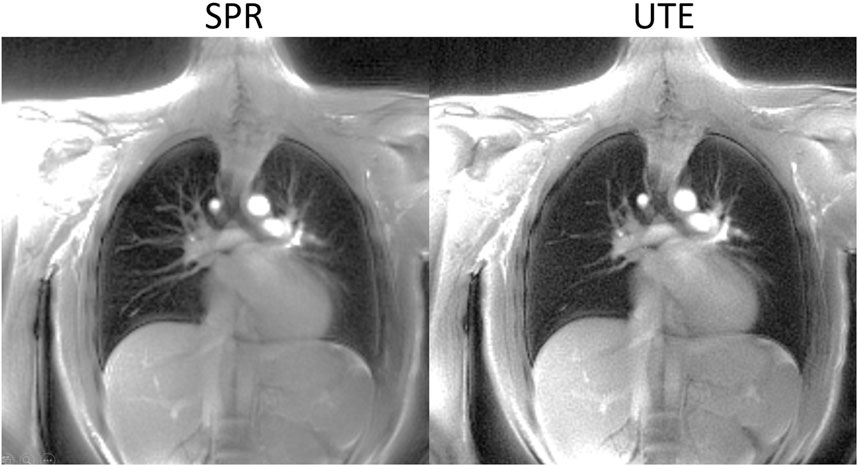
Figure 2. 2D coronal lung images during expiration stage. Both images were reconstructed using the
As they form the core for image-based self-gating reconstruction techniques, as well as nuSG, the low-spatial high-temporal resolution images were further analyzed. A single frame of the sliding window reconstruction for SPR and radial UTE at all reconstructed temporal resolutions is shown in Figure 3. The aliasing artifacts resulting from the undersampling during sliding window reconstruction visibly increases for lower temporal resolutions, but, while radial UTE produces distinct spoke-like artifacts, the noise in the SPR images appears more evenly distributed. Additionally, since with SPR, the entire petal is used for the sliding window reconstruction, the signal intensity is visibly higher in the liver compared to radial UTE. The full sliding window reconstructions can be found in the Supplementary Material S1–S6.
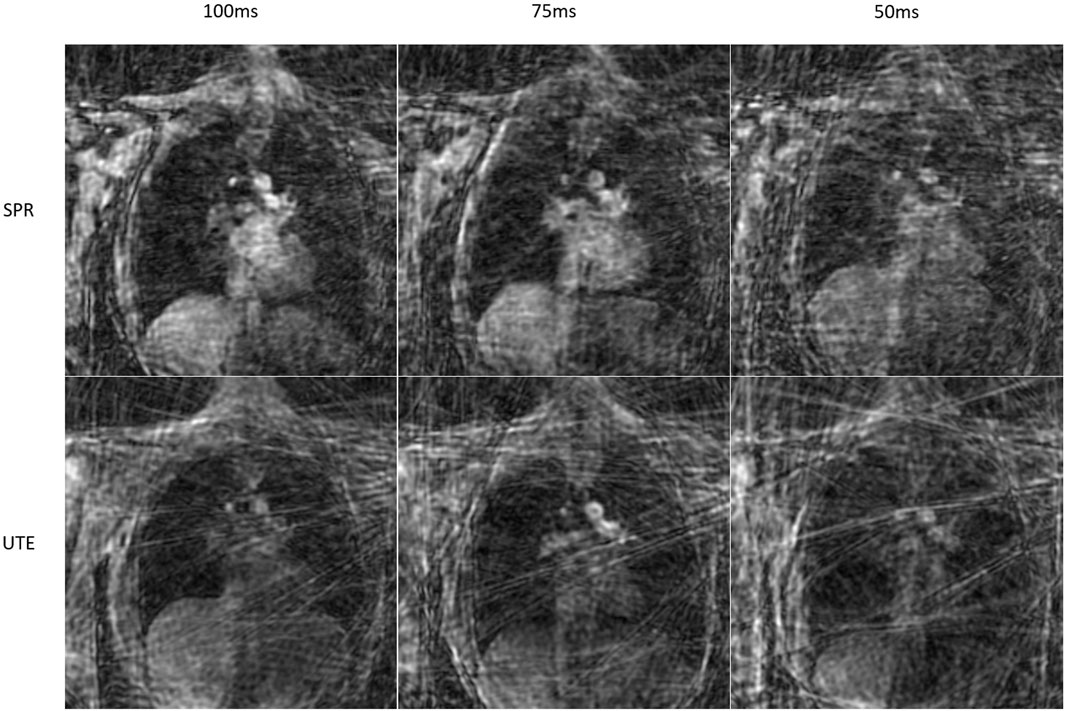
Figure 3. Single frame of the low-spatial high-temporal resolution images used for image-based self-gating techniques, as well as nuSG. The top row shows the SPR images, the bottom row the radial UTE images. From left to right, the columns correspond to a temporal resolution of 100, 75 and 50 ms. Clear spoke-artifacts can be seen in the radial UTE images, whereas the noise in the SPR images is more homogeneous.
Figure 4 shows the time course of the profile identified over the LLI that is used for image based gating and nuSG for all temporal resolutions for SPR and radial UTE. The self gating signal that was obtained using gradient analysis is shown in red. The algorithm reliably tracks the LLI for 100 and 75 ms for the SPR trajectory with few outliers even at 50 ms temporal resolution. For radial UTE, the algorithm produces several outliers already at 100 ms temporal resolution. The number of outliers increases as temporal resolution decreases, leading to only a low level of correlation between the automatically tracked LLI and the actual breathing pattern. The fitted correlation matrices used for nuSG reconstruction for SPR and radial UTE for all temporal resolutions can be found in the Supplementary Material S7.
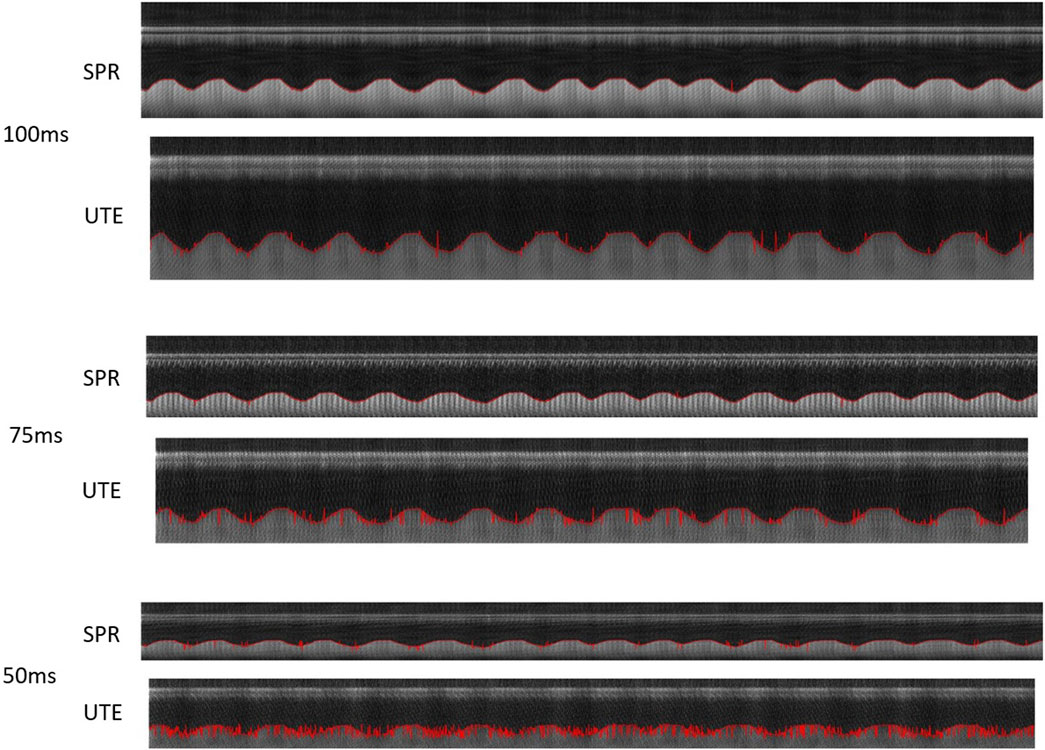
Figure 4. By identifying a line profile over the LLI in high-temporal low-spatial resolution images, a time course corresponding to the breathing cycle can be constructed. These time courses are shown for temporal resolutions of 100, 75 and 50 ms for SPR and radial UTE. The self-gating signal, obtained by gradient analysis is shown in red.
3.2 Sharpness
The line profiles across the LLI for both trajectories at all temporal resolutions that were used for sharpness analysis of one volunteer are shown in Figure 5 for SPR and radial UTE during breath-hold, as well as for all analyzed self-gating techniques at temporal resolutions of 100, 75 and 50 ms. Especially for radial UTE combined with nuSG, a clear decay in image sharpness for decreased temporal resolution is visible in the line profile over the LLI.
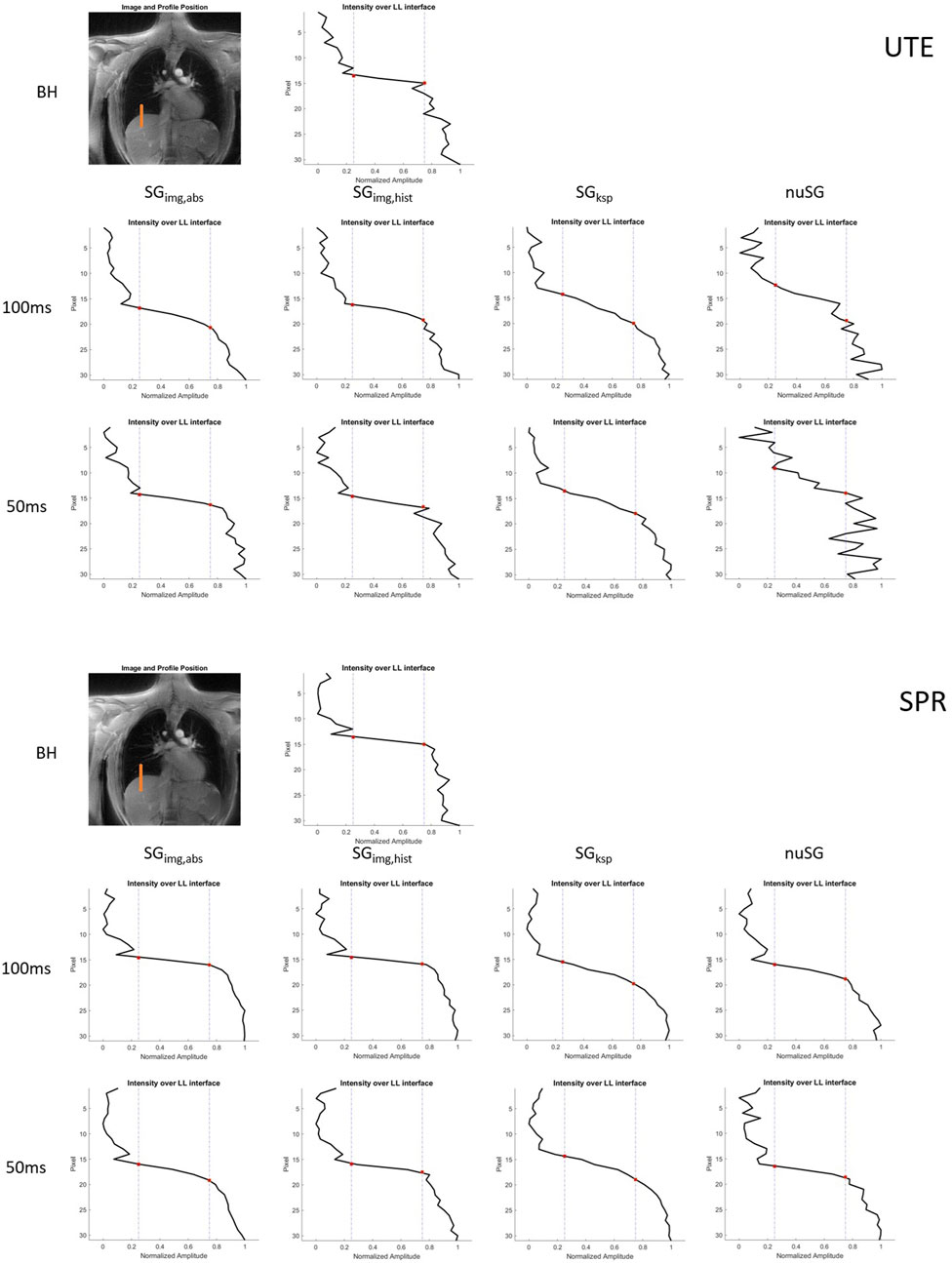
Figure 5. Sharpness analysis of a line profile over the LLI, depicted in orange. Images in top show data acquired using radial UTE for breath-hold (BH), as well as all self-gating techniques (
Mean image sharpness is listed in Table 2. The percentage decrease when comparing the sharpness value measured for SPR acquired images with the sharpness obtained from radial UTE acquired images is shown in Figure 6. The data is presented in green for end-inspiration stage and in blue for end-expiration stage. Especially the image-based self-gating techniques yield best results for a temporal resolution of 75 ms. Also noticeable is the approximation of the performance comparing SPR to radial UTE during end-expiration stage when using nuSG.
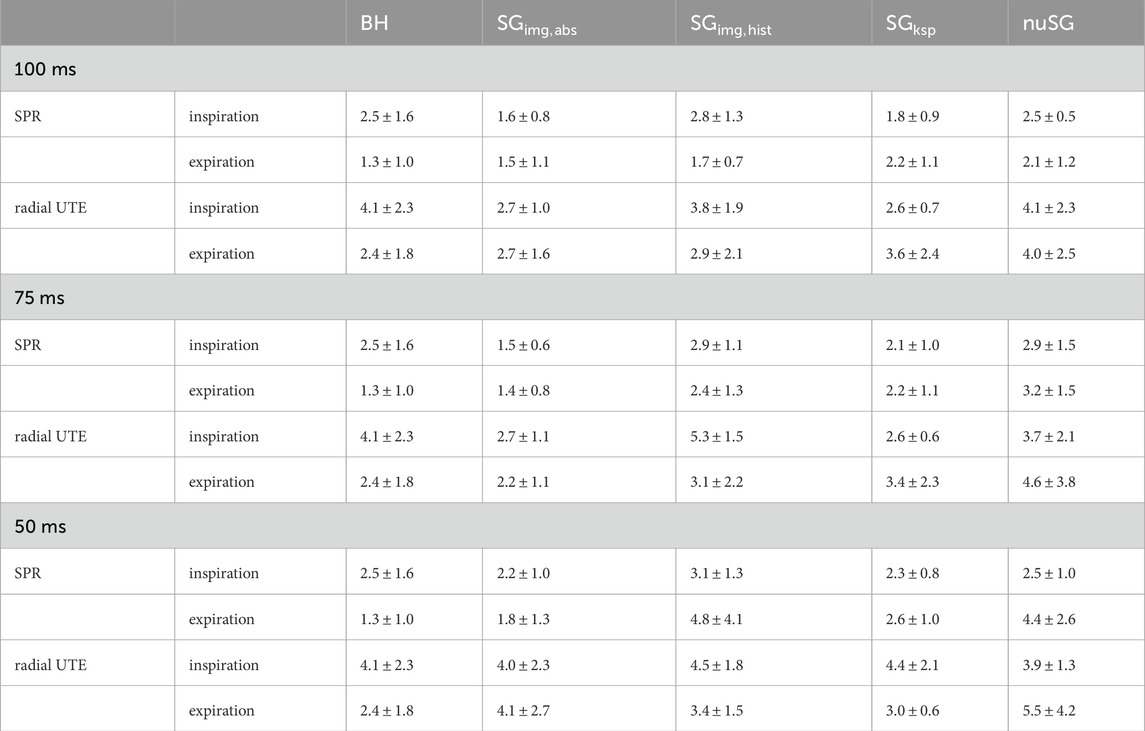
Table 2. Mean sharpness values calculated for a line profile over the lung-liver interface for breath-hold and self-gated images of both trajectories at all investigated temporal resolutions.
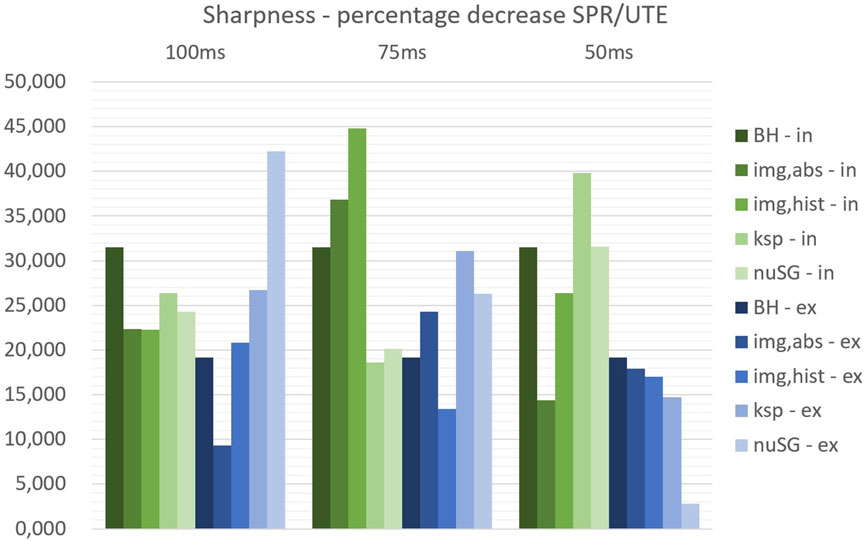
Figure 6. Improved image sharpness when comparing SPR acquired data with data acquired using radial UTE. The green bars represent data from end-inspiratory phase, blue bars correspond to the end-expiratory phase. Breath-hold (BH), as well as all self-gating techniques (
3.3 SNR
Mean SNR values in the lung parenchyma inclunding
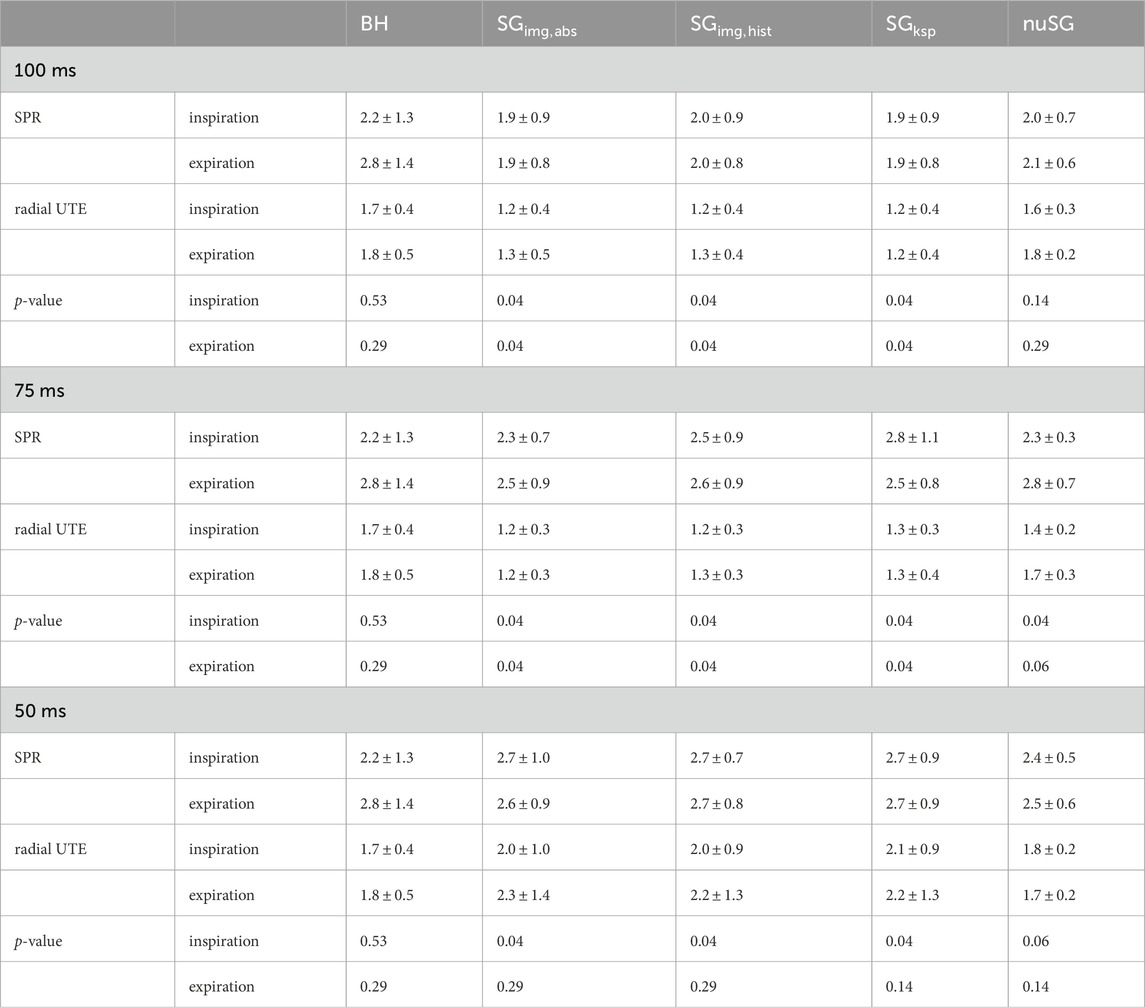
Table 3. Mean SNR values in the lung parenchyma for breath-hold and self-gated images of both trajectories at all investigated temporal resolutions, as well as

Figure 7. Percentage increase of the SNR value when comparing SPR acquired data with data acquired using radial UTE. The green bars represent data from end-inspiratory phase, blue bars correspond to the end-expiratory phase. Breath-hold (BH), as well as all self-gating techniques (
4 Discussion
The intrinsic advantage of more efficient sampling of k-space of the SPR trajectory is exploited in the low-spatial high-temporal resolution images used for image-based retrospective self-gating techniques. As discussed in [12], undersampling artifacts are more evenly distributed and lack the distinct spoke-like structure found in radial UTE. This is also clearly visible in Figure 3, leading to a more robust performance of the gradient analysis, used to determine the position of the LLI. Additionally, the longer read-out duration increases signal in the liver due to higher
Although overall image quality is good for radial UTE and SPR, especially for the nuSG self-gating technique, limits in temporal resolution can be seen in radial UTE images, already at temporal resolutions of 100 ms and even for SPR at 50 ms. The performance decrease correlated with temporal resolution is most noticeable for nuSG reconstruction. Artifacts start showing at temporal resolutions of 75 ms for SPR but still acceptable image quality can be achieved for 50 ms. For radial UTE, artifacts are already more prominent at a temporal resolution of 100 ms compared to SPR at a temporal resolution of 50 ms and decreasing for higher temporal resolutions.
The advantageous performance of the image-based gating techniques can especially be seen in the sharpness values. While for all gating techniques a percentage increase in sharpness can be found, when comparing SPR to radial UTE, especially image-based techniques show greatest improvement for a temporal resolution of 75 ms. For a temporal resolution of 100 ms the advantages of SPR are not as obvious, since radial UTE performs well enough. For a temporal resolution of 50 ms, while SPR still yields acceptable results, the overall decrease in gating performance is already noticeable.
A similar outcome is observed for SNR comparison between SPR and radial UTE. While for all gating techniques and all temporal resolutions, SPR yields higher SNR values compared to radial UTE, the improvements are highest for a temporal resolution of 75 ms, exceeding even the improvement found in breath-hold images. For a temporal resolution of 100 ms, the improvement found in breath-hold images is slightly superior for image-based and k-space based self-gating during end-inspiratory phase. For a temporal resolution of 50 ms the overall improvement is lowest, due to decreasing gating performance of SPR.
There is a huge body of recent publications on lung imaging. They can mainly be categorized in zero-echo time (ZTE) [28], ultra-short echo time [28] and conventional FLASH [29] imaging techniques. With ZTE being an intrinsically 3D sequence and as such yielding more SNR and superior isotropic spatial resolution as in the 2D approaches, its general application on clinical systems is limited, especially by the required rapid switch times between transmit/receive mode of the frontend to avoid substantial loss of k-space center coverage. The conventional FLASH sequences have predominantly been applied to very low spatial resolution acquisitions, mainly providing mean intensity information of the parenchyma which is applied for deriving signal intensity changes over time to derive lung function information, rather than anatomic details. The suggested approach represents an efficient variant of the UTE techniques. UTE techniques have a high self-gating potential and in principle capable of trading spatial vs. temporal resolution and, as such, can be applied for high-resolution anatomic, as well as low-resolution functional assessment of the lung. Where the basic contrasts is still UTE-like, the main advantage of the presented trajectory results from the almost doubled temporal resolution of the low-resolution images applied for respiratory gating. The presented trajectory clearly improved the correct identification of the LLI during gating and results in a respective image sharpness improvement.
A major limitation of the study rises from the small cohort size. But even though only six volunteers were enrolled, a significant increase in SNR for the majority of SNR values and a clear trend to sharper LLI were already observed when compared to UTE. Further the feasibility of using a better temporal fidelity for the images applied to deriving the gating signal is already clearly appreciable from the provided data.
5 Conclusion
The higher efficiency in k-space sampling of the full-petal SPR images compared to radial UTE can be ideally exploited when using full-petal data for low-spatial high-temporal resolution images as a base for image-based self-gating techniques. Since the final gated images can be reconstructed using only the center-out half of the SPR trajectory, the image contrast is equivalent to radial UTE images, leading to an easy comparison and interpretation of images in clinical settings.
The structure of undersampling artifacts, as well as higher liver signal due to longer read-out duration further improves the gating performance of image-based self-gating techniques.
For all temporal resolutions, SPR outperforms radial UTE. Image-based self-gating techniques show no apparent artifacts for temporal resolutions as low as 50 ms. This suggests that temporal resolutions of 50 ms are suitable for SPR data when using image-based self-gating techniques with image quality comparable to a temporal resolution of 100 ms of radial UTE.
A combination of SPR with retrospective self-gating has been proven suitable, making the trajectory an excellent candidate for further investigation of 3D lung imaging.
SPR further holds the intrinsic possibility of reconstructing images of different contrasts by using different parts of the petal. The full petal data benefit of a low-fat signal due to the position of the second echo, which could be beneficial, especially for cardiac applications.
Data availability statement
The original contributions presented in the study are included in the article/Supplementary Material, further inquiries can be directed to the corresponding author.
Ethics statement
The studies involving humans were approved by Ethikkommission der Universität Ulm. The studies were conducted in accordance with the local legislation and institutional requirements. The participants provided their written informed consent to participate in this study.
Author contributions
HF: Conceptualization, Data curation, Formal Analysis, Investigation, Methodology, Visualization, Writing – original draft, Writing – review and editing. VR: Conceptualization, Funding acquisition, Project administration, Supervision, Writing – review and editing.
Funding
The author(s) declare that financial support was received for the research and/or publication of this article. This work was funded by the German Research Foundation under grant agreement 465599659.
Acknowledgments
The authors thank the Ulm University Centre for Translational Imaging MoMAN for its support. The continuous support by Philips Healthcare is highly appreciated by the authors.
Conflict of interest
The authors declare that the research was conducted in the absence of any commercial or financial relationships that could be construed as a potential conflict of interest.
The author(s) declared that they were an editorial board member of Frontiers, at the time of submission. This had no impact on the peer review process and the final decision.
Generative AI statement
The author(s) declare that no Generative AI was used in the creation of this manuscript.
Publisher’s note
All claims expressed in this article are solely those of the authors and do not necessarily represent those of their affiliated organizations, or those of the publisher, the editors and the reviewers. Any product that may be evaluated in this article, or claim that may be made by its manufacturer, is not guaranteed or endorsed by the publisher.
Supplementary material
The Supplementary Material for this article can be found online at: https://www.frontiersin.org/articles/10.3389/fphy.2025.1611544/full#supplementary-material
References
1. Zapke M, Topf H, Mea Z, Kuth R, Deimling M, Kreisler P, et al. Magnetic resonance lung function – a breakthrough for lung imaging and functional assessment? a phantom study and clinical trial. Respir Res (2006) 7:106. doi:10.1186/1465-9921-7-106
2. Wielpütz M, Kauczor HU. Mri of the lung: state of the art. Diagn Interv Radiol (2012) 18:344–53. doi:10.4261/1305-3825.DIR.5365-11.0
3. Bergin CJ, Pauly JM, Macovski A. Lung parenchyma: projection reconstruction mr imaging. Radiology (1991) 179:777–81. doi:10.1148/radiology.179.3.2027991
4. Weiger M, Brunner DO, Dietrich BE, Müller CF, Pruessmann KP. Zte imaging in humans. Magn Reson Med (2013) 70:328–32. doi:10.1002/mrm.24816
5. Yu J, Xue Y, Song HK. Comparison of lung t2* during free-breathing at 1.5 t and 3.0 t with ultrashort echo time imaging. Magn Reson Med (2011) 66:248–54. doi:10.1002/mrm.22829
6. Johnson KM, Fain SB, Schiebler ML, Nagle S. Optimized 3d ultrashort echo time pulmonary mri. Magn Reson Med (2013) 70:1241–50. doi:10.1002/mrm.24570
7. Balasch A, Metze P, Stumpf K, Beer M, Büttner SM, Rottbauer W, et al. 2d ultrashort echo-time functional lung imaging. J Magn Reson Imaging (2020) 52:1637–44. doi:10.1002/jmri.27269
8. Wild JM, Marshall H, Bock M, Schad LR, Jakob PM, Puderbach M, et al. Mri of the lung (1/3): methods. Insights into imaging (2012) 3:345–53. doi:10.1007/s13244-012-0176-x
9. Biederer J, Beer M, Hirsch W, Wild J, Fabel M, Puderbach M, et al. Mri of the lung (2/3). why. when. how? Insights into imaging (2012) 3:355–71. doi:10.1007/s13244-011-0146-8
10. Hatabu H, Alsop DC, Listerud J, Bonnet M, Gefter WB. T2* and proton density measurement of normal human lung parenchyma using submillisecond echo time gradient echo magnetic resonance imaging. Eur J Radiol (1999) 29:245–52. doi:10.1016/s0720-048x(98)00169-7
11. Bae K, Jeon KN, Hwang MJ, Lee JS, Ha JY, Ryu KH, et al. Comparison of lung imaging using three-dimensional ultrashort echo time and zero echo time sequences: preliminary study. Eur Radiol (2019) 29:2253–62. doi:10.1007/s00330-018-5889-x
12. Frantz H, Speidel T, Rasche V. Single-petal rosette trajectory for 2d functional lung imaging. Front Phys (2024) 12:1360083. doi:10.3389/fphy.2024.1360083
13. Ooms N, Shen X, Özen AC, Ilbey S, Chiew M, Emir U. Pulmonary imaging using 3d dual-echo fid ultra-short echo time mri with rosette k-space pattern: introduction and feasibility. Proc Intl Soc Mag Reson Med (2022) 30:1040.
14. Shen X, Özen AC, Sunjar A, Ilbey S, Sawiak S, Shi R, et al. Ultra-short t2 components imaging of the whole brain using 3d dual-echo ute mri with rosette k-space pattern. Magn Reson Med (2023) 89:508–21. doi:10.1002/mrm.29451
15. Shen X, Caverzasi E, Yang Y, Liu X, Green A, Henry RG, et al. 3d balanced ssfp ute mri for multiple contrasts whole brain imaging. Magn Reson Med (2024) 92:702–14. doi:10.1002/mrm.30093
16. Villarreal CX, Shen X, Alhulail AA, Buffo NM, Zhou X, Pogue E, et al. An accelerated petalute mri sequence for in vivo quantification of sodium content in human articular cartilage at 3t. Skeletal Radiol (2025) 54:601–10. doi:10.1007/s00256-024-04774-5
17. Weick S, Breuer FA, Ehses P, Völker M, Hintze C, Biederer J, et al. Dc-gated high resolution three-dimensional lung imaging during free-breathing. J Magn Reson Imaging (2013) 37:727–32. doi:10.1002/jmri.23798
18. Higano NS, Hahn AD, Tkach JA, Cao X, Walkup LL, Thomen RP, et al. Retrospective respiratory self-gating and removal of bulk motion in pulmonary ute mri of neonates and adults. Magn Reson Med (2017) 77:1284–95. doi:10.1002/mrm.26212
19. Richter JA, Wech T, Weng AM, Stich M, Weick S, Breuer K, et al. Free-breathing self-gated 4d lung mri using wave-caipi. Magn Reson Med (2020) 84:3223–33. doi:10.1002/mrm.28383
20. Tibiletti M, Paul J, Bianchi A, Wundrak S, Rottbauer W, Stiller D, et al. Multistage three-dimensional ute lung imaging by image-based self-gating. Magn Reson Med (2016) 75:1324–32. doi:10.1002/mrm.25673
21. Wundrak S, Paul J, Ulrici J, Hell E, Geibel MA, Bernhardt P, et al. A self-gating method for time-resolved imaging of nonuniform motion. Magn Reson Med (2016) 76:919–25. doi:10.1002/mrm.26000
22. Beatty PJ, Nishimura DG, Pauly JM. Rapid gridding reconstruction with a minimal oversampling ratio. IEEE Trans Med Imaging (2005) 24:799–808. doi:10.1109/tmi.2005.848376
23. Robison RK, Devaraj A, Pipe JG. Fast, simple gradient delay estimation for spiral mri. Magn Reson Med (2010) 63:1683–90. doi:10.1002/mrm.22327
24. Atkinson IC, Lu A, Thulborn KR. Characterization and correction of system delays and eddy currents for mr imaging with ultrashort echo-time and time-varying gradients. Magn Reson Med (2009) 62:532–7. doi:10.1002/mrm.22016
25. Metze P, Frantz H, Straubmüller F, Speidel T, Stumpf K, Beer M, et al. Non-uniform self-gating in 2d lung imaging. Front Phys (2022) 10:836178. doi:10.3389/fphy.2022.836178
26. Constantinides CD, Atalar E, McVeigh ER. Signal-to-noise measurements in magnitude images from nmr phased arrays. Magn Reson Med (1997) 38:852–7. doi:10.1002/mrm.1910380524
27. Larson AC, Kellman P, Arai A, Hirsch GA, McVeigh E, Li D, et al. Preliminary investigation of respiratory self-gating for free-breathing segmented cine mri. Magn Reson Med Official J Int Soc Magn Reson Med (2005) 53:159–68. doi:10.1002/mrm.20331
28. Bae K, Jeon KN, Hwang MJ, Lee JS, Park SE, Kim HC, et al. Respiratory motion–resolved four-dimensional zero echo time (4d zte) lung mri using retrospective soft gating: feasibility and image quality compared with 3d zte. Eur Radiol (2020) 30:5130–8. doi:10.1007/s00330-020-06890-x
Keywords: lung MRI, UTE imaging, retrospective self-gating, image based self-gating, breath-hold
Citation: Frantz H and Rasche V (2025) Retrospective self-gating for single-petal rosette trajectory in 2D lung imaging. Front. Phys. 13:1611544. doi: 10.3389/fphy.2025.1611544
Received: 14 April 2025; Accepted: 04 July 2025;
Published: 25 July 2025.
Edited by:
Gisela E Hagberg, University of Tübingen, GermanyCopyright © 2025 Frantz and Rasche. This is an open-access article distributed under the terms of the Creative Commons Attribution License (CC BY). The use, distribution or reproduction in other forums is permitted, provided the original author(s) and the copyright owner(s) are credited and that the original publication in this journal is cited, in accordance with accepted academic practice. No use, distribution or reproduction is permitted which does not comply with these terms.
*Correspondence: Volker Rasche, dm9sa2VyLnJhc2NoZUB1bmktdWxtLmRl
 Hanna Frantz
Hanna Frantz Volker Rasche
Volker Rasche